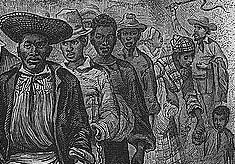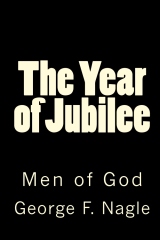
Bedford County, Pennsylvania
19th Century Free African American Information
Salemville, South Woodbury Township
James H. Lyons Obituary, 1 December 1899
James H. Lyons
James H. Lyons, colored, died at his home in Salemville on Friday night about eleven o'clock. He was aged seventy-four years. Decedent came to Salemville when a boy and has resided there ever since. For many years he conducted a general merchandise store. He was the first postmaster at Salemville and, with the exception of two terms, filled that position since the office was established. A short time ago he was appointed to succeed Postmaster King, who recently resigned. He was supervisor for a long time. His wife died about fifteen years ago. He is survived by ten or eleven children. Mr. Lyons was a member of the Brethren church. He was an intelligent, sober, honest and industrious citizen.
Notes
We find James Lyons living in Woodbury Township in the 1850 census. He is listed as a 21 year-old farmer, living with Sarah Lyons, age 17, and a child, George, age 3. The residence next to his is occupied by the Benjamin Lyons family, consisting of Benjamin, age 70, Polly, age 39, Richard, age 21 and Catharine, age 16. All persons in both families are listed as having been born in Pennsylvania. Ten years later, in the 1860 census, James Lyons, age 35 (note the age discrepancy from the 1850 census), is the head of a large family that includes Benjamin F., age 9, Mary A., age 7, Catharine, age 6, Nancy J., age 5, Sarah, age 4, David J., age 3, Amanda, age 2 and the infant James L, seven months old. Living next to the James Lyons family is Mary Lyons, age 64, and Sarah Lyons (James' wife), age 29. Sarah is listed as a "house maid." Mary Lyons owns $4,000 in real estate and James owns $1,000 in real estate. Everyone is listed as having been born in Pennsylvania, except for Sarah Lyons, who was born in Maryland. In 1870, Sarah is back in James' household, and the couple have added six additional children since the last census.
The Historical Sketches of Morrison's Cove, by Rev. Karns, tells us that James Lyons was appointed postmaster of Salemville on July 19, 1882. He held that post for over ten years, and was appointed again on November 16, 1899. He served in that position until his death.
Sources
Bedford Gazette, 1 December 1899. Copy forwarded by Pat Holt. Ms. Holt notes: "I am [the] granddaughter of one of your lumens, Cal Bell of Altoona. I came across this obituary today while looking through the Bedford Gazette of Dec. 1, 1899. I felt so good when I read about Mr. Lyons and what he accomplished and how he was remembered I thought that I would send it to you."
Census of the United States, 1850, South Woodbury Township, Bedford County, Pennsylvania, page 220.
Census of the United States, 1860, South Woodbury Township, Bedford County, Pennsylvania, page 593.
Census of the United States, 1870, South Woodbury Township, Bedford County, Pennsylvania, page 648.
Karns, Rev. C. W., Historical Sketches of Morrison's Cove, Altoona, PA, Mirror Press, 1933, page 295.
Now Available to Read
The Year of Jubilee
Vol. 1: Men of God and Vol. 2: Men of Muscle
by George F. Nagle
 Both volumes of the Afrolumens book are now
Both volumes of the Afrolumens book are now
available to read on this site
The Year of Jubilee is the story of Harrisburg'g free African American community, from the era of colonialism and slavery to hard-won freedom.
Volume One, Men of God, covers the turbulent beginnings of this community, from Hercules and the first slaves, the growth of slavery in central Pennsylvania, the Harrisburg area slave plantations, early runaway slaves, to the birth of a free black community. Men of God is a detailed history of Harrisburg's first black entrepreneurs, the early black churches, the first black neighborhoods, and the maturing of the social institutions that supported this vibrant community.
It includes an extensive examination of state and federal laws governing slave ownership and the recovery of runaway slaves, the growth of the colonization movement, anti-colonization efforts, anti-slavery, abolitionism and radical abolitionism. It concludes with the complex relationship between Harrisburg's black and white abolitionists, and details the efforts and activities of each group as they worked separately at first, then learned to cooperate in fighting against slavery. More here
Non-fiction, history. 607 pages, softcover.
 Volume
Two, Men of Muscle takes the story from 1850 and the Fugitive Slave
Law of 1850, through the explosive 1850s to the coming of Civil War
to central Pennsylvania. In this volume, Harrisburg's African American
community weathers kidnappings, raids, riots, plots, murders, intimidation,
and the coming of war. Caught between hostile Union soldiers and deadly
Confederate soldiers, they ultimately had to choose between fleeing
or fighting. This is the story of that choice.
Volume
Two, Men of Muscle takes the story from 1850 and the Fugitive Slave
Law of 1850, through the explosive 1850s to the coming of Civil War
to central Pennsylvania. In this volume, Harrisburg's African American
community weathers kidnappings, raids, riots, plots, murders, intimidation,
and the coming of war. Caught between hostile Union soldiers and deadly
Confederate soldiers, they ultimately had to choose between fleeing
or fighting. This is the story of that choice.
Non-fiction, history. 630 pages, softcover.

